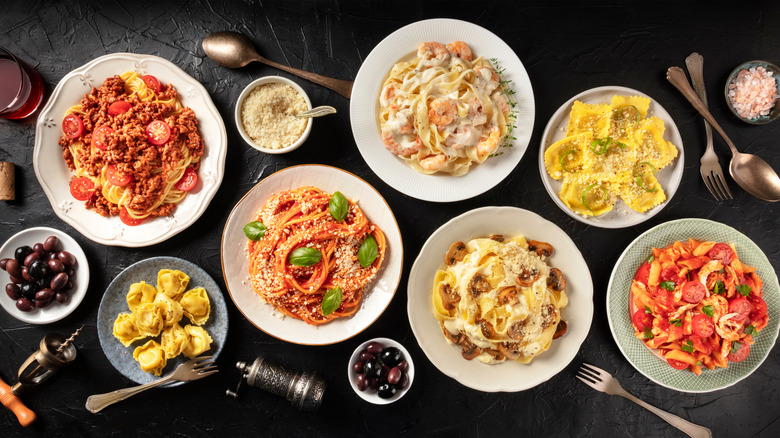Bobby Flay Just Explained The Real Difference Between Fresh And Dry Pasta
Pasta is one of those dishes that you think you may have totally nailed. Come on, it's just a bit of boiling water, some salt, and some pasta, right?
Totally wrong.
While it may be hard to totally botch pasta (although we're sure it can be done!), there are so many ways to make your pasta dish that much better, says Greatist, like ensuring you use a pot that's big enough for the pasta to have its own space to boil in, paying attention to cooking times, salting it more than you think you should, and even saving a bit of pasta water and adding it to your sauce to help thicken it. These are all awesome, must-know tricks to help make your Italian staple taste better at home.
But, did you know that there is one thing that will really help make your pasta dish stand out? The actual noodles themselves. There are two kinds of pasta — fresh and dry — and the one you choose to use for your dish can impact everything, says this celebrity chef.
Bobby Flay explains the main difference between the two pasta types
Luckily, we have the wise counsel of Bobby Flay to guide us in our pasta-making choices. The chef, who is known more for his Southwestern-style cuisine, had something to say about the difference between dry and fresh pasta. On his recent "Always Hungry" podcast, which he does with his daughter Sophie, Flay broke down this Italian specialty.
"Pasta, in general, is usually eggs and flour," he explains. "Those pastas that are going to be turned into dry pasta have semolina and water. No eggs. I don't know why, but I always feel like I want eggs in my pasta. I like the bite it gives."
But the real difference between fresh and dried pasta, notes Flay: "Fresh pasta is going to be a lot silkier and will have less substance to it, usually. It's silkier and it's luscious and that works in lots of different ways," he says, pointing out another difference. "Dried pasta takes longer to cook, most of the time, because it's dry. You can also flavor the fresh pasta, which I love — like squid ink."
However, fresh isn't always best, Flay cautions. "One's not better than the other, they're just very different. Just because it's fresh, doesn't mean it's better for a dish," he says. Flay says that some classic dishes, like spaghetti and meatballs and linguine with clam sauce, are better with dried pasta. But fresh pasta, he says, works better with a white truffle dish or something a bit lighter. Now that you know, you can create the best gourmet Italian dishes right at home.

